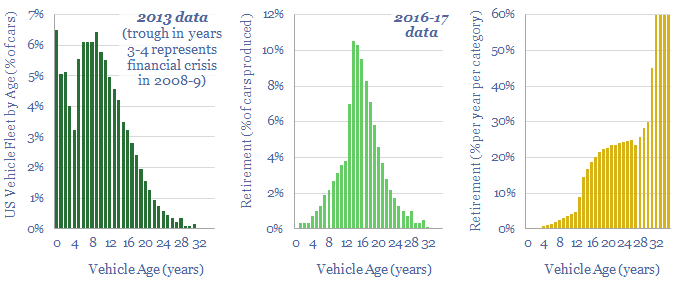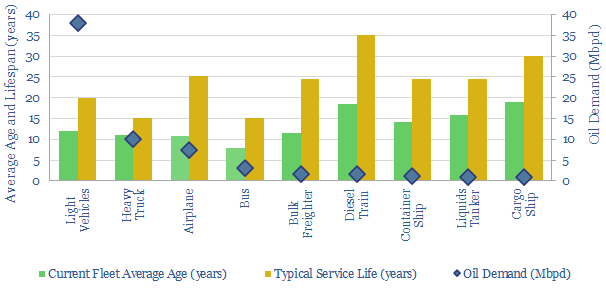The weighted-average combustion vehicle in the world has a current age of 12-years and an expected service life of 20-years. In other words, a new combustion vehicle entering the global fleet in 2023 will most likely be running through 2043. Useful data and notes are compiled here.
How long will new combustion vehicles remain in service and contribute to global oil demand? To answer this question, we have compiled data into different vehicle types.
One method to estimate the average service life of a vehicle is simply to take the average age of that type of vehicle in today’s fleet as a proxy. For example, the average passenger car in operation is around 12-years old, implying that half of cars might last less than 12-years and half last longer.
However this is a 25-50% under-estimate of ultimate vehicle life, because unless all global vehicles are suddenly scrapped tomorrow, then most of these vehicles will last a good while longer. The average age at retirement for vehicles in the US is closer to 16-years (charts below).
In many categories, the average has been pulled downwards by rapid expansion of the fleet in the emerging world. For example, some of the world’s youngest airplane fleets today belong to China’s Hainan Airlines (5.1-years), Saudia (5.1-years), Sichuan Airlines (5.7-years) and Brazil’s Azul Linhas (6.0-years). Likewise, the excellent “global bus survey” notes that the age of the average bus in service globally has effectively been halved by rapid growth of the bus fleet in China, Russia, Brazil, Indonesia, Mexico and Korea.
Another challenge is that vehicles getting retired in the developed world often simply get transported to frontier economies in the emerging world, where they have an entire second life. Africa imported 1.5M vehicles from the US, EU and Japan in 2018, and a significant share are over 15-years old at the time of arrival (!). The UN is advocating for tighter legislation here. For example, in 2022, Nigeria lowered the age limit on imported vehicles from 15-years to 12-years.
There are also broad distributions in vehicle ages, around the stated averages (chart below). And the rate of new vehicle purchases and old vehicle retirements also seems to fluctuate with economic conditions.

Hence we think the best overall estimates for vehicle lives is the targeted service life from the manufacturer, and some guidelines are tabulated in the data-file along with our notes. The average combustion vehicle entering service in 2023 is expected to last 20-years.
The shortest vehicle lifespans are expected for buses and heavy trucks, at c15-years, while the longest service lives are expected for new planes, ships and trains at 25-35 years.
The longest-lasting vehicles in our data-set include 0.5% of passenger cars in the US that are over 30-years old (chart above), and we also occasionally see a Soviet Zhiguli death-trap on the roads in Tallinn over here in the year of our lord 2023. Elsewhere, there are rail cars in service with half-a-century of history. In 2021, Mitsui noted it had scrapped its first LNG carrier, the Sunshu Maru, after a 37-year service life starting in 1984. And there are planes still taking to the skies that were constructed in 1978-81 before the oil shocks (e.g. from Iranian and Venezuelan carriers).
The full data-file contains estimates into the current fleet age (in years) and service life (years) for different types of vehicles, such as light vehicles, heavy trucks, airplanes, buses, bulk freighters, diesel trains, container ships, liquid tankers and other general ships.

